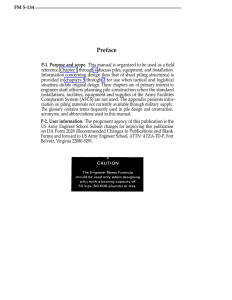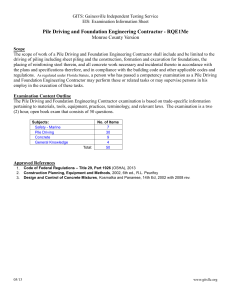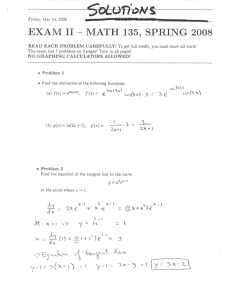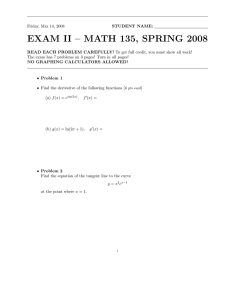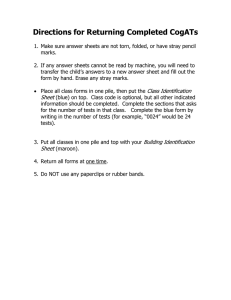S 2 1*
advertisement
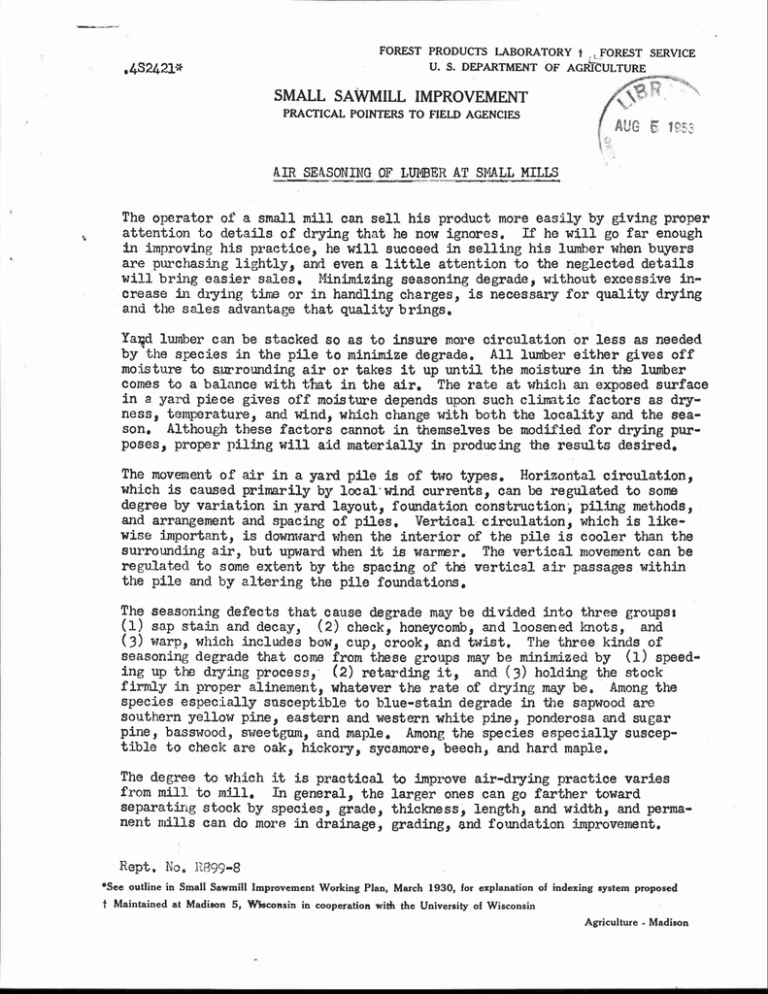
.4S 24 21* FOREST PRODUCTS LABORATORY t ,FOREST SERVICE U. S. DEPARTMENT OF AGRICULTURE SMALL SAWMILL IMPROVEMENT PRACTICAL POINTERS TO FIELD AGENCIES AIR SEASONING OF LUMBER AT SMALL MILLS The operator of a small mill can sell his product more easily by giving proper attention to details of drying that he now ignores. If he will go far enough in improving his practice, he will succeed in selling his lumber when buyers are purchasing lightly, and even a little attention to the neglected details will bring easier sales. Minimizing seasoning degrade, without excessive increase in drying time or in handling charges, is necessary for quality drying and the sales advantage that quality brings. Yard lumber can be stacked so as to insure more circulation or less as needed by the species in the pile to minimize degrade. All lumber either gives off moisture to surrounding air or takes it up until the moisture in the lumber comes to a balance with tint in the air. The rate at which an exposed surface in a yard piece gives off moisture depends upon such climatic factors as dryness, temperature, and wind, which change with both the locality and the season. Although these factors cannot in themselves be modified for drying purposes, proper piling will aid materially in producing the results desired. The movement of air in a yard pile is of two types. Horizontal circulation, which is caused primarily by local wind currents, can be regulated to some degree by variation in yard layout, foundation construction; piling methods, and arrangement and spacing of piles. Vertical circulation, which is likewise important, is downward when the interior of the pile is cooler than the surrounding air, but upward when it is warmer. The vertical movement can be regulated to some extent by the spacing of the vertical air passages within the pile and by altering the pile foundations. The seasoning defects that cause degrade may be divided into three groups: (1) sap stain and decay, (2) check, honeycomb, and loosened knots, and (3) warp, which includes bow, cup, crook, and twist. The three kinds of seasoning degrade that come from these groups may be minimized by (1) speeding up the drying process, (2) retarding it, and (3) holding the stock firmly in proper alinement, whatever the rate of drying may be. Among the species especially susceptible to blue-stain degrade in the sapwood are southern yellow pine, eastern and western white pine, ponderosa and sugar pine, basswood, sweetgum, and maple. Among the species especially susceptible to check are oak, hickory, sycamore, beech, and hard maple. The degree to which it is practical to improve air-drying practice varies from mill to mill. In general, the larger ones can go farther toward separating stock by species, grade, thickness, length, and width, and permanent mills can do more in drainage, grading, and foundation improvement. Rept. No. R899-8 • See outline in Small Sawmill Improvement Working Plan, March 1930, for explanation of indexing system proposed Maintained at Madison 5, Wisconsin in cooperation with the University of Wisconsin Agriculture - Madison More extensive discussion of air drying, including the use of special equipment for handling packages of lumber, is given in FPL Report No. R1657, available from the Forest Products Laboratory, Madison 5, Wis. Flat Piling Ordinarily, lumber is piled flatwise for drying. With this method the drying rate is relatively slow and the weight of the pile tends to keep the stock from warping. It is therefore suited to species in which check, honeycomb, and warp are likely to occur and less suited to species in which sap-stain degrade is probable. The following suggestions apply to flat piling. Choose a well-drained site; for species that withstand rapid drying, it should be fully exposed to the wind. Free it from brush and weeds. The foundations must be firm and must raise the pile above the ground to assist air circulation under it. Piers and beams are highly preferable to other typef of support, such as stringers laid on the surface of the ground. At permanent yards a practical construction consists of piers of concrete or creosoted timber supporting substantial stringers across which beams for sticker support are spiked. At portable operations, foundations of standard stock to be marketed when the pile is torn down can be made as follows: Crosscut a reasonably sound 15-inch log of low value into bolts to provide piers that elevate the first course of lumber at least 18 inches from the ground and give it a slope of 1 inch to the foot from front to rear. Scrape to firm soil at 12 points and bed the piers carefully (fig. 1). Give the front of the pile a pitch toward the alley of 1 inch to the foot of height and aline each-tier of stickers parallel to this front. Make the front of the pile smooth, avoiding especially projecting ends that would lead rain or drip into the pile. Some separation of stock by thickness and species is usually practicable and, in softwoods, by length. An elementary length grouping consists in putting 6-, 10-, and 12-foot lengths in one pile and 8-, 14-, and 16-foot lengths in another, For this lay a cross beam on each row of three piers, using a 6- by 8-inch beam or its equivalent (fig. I). -In laying courses, intersperse the longer stock uniformly across the pile, always placing a long piece on the outsidd and keeping each tier of uniform length. Adjacent short-length tiers of boards should be flush-with the front and rear faces of the pile (box piling). Softwood boards 3, 4, and 5 inches wide can be put in the same pile. The 6-, $ -, 10-, and 12-inch widths are piled separately. Space boards in the course 3 inches apart and place boards in successive courses directly over those below. In the case of 2 by 41s likely to crook, pile the 2- by 4-inch stock with the 4-inch face vertical and space adjacent pieces in the course 1 inch apart laterally. Sticker with 2- by 4-inch stock, with the 4-inch face horizontal, placing. one sticker over each beam, making four to the course for the 16-foot stock or three for the 12-foot stock. Hardwoods are usually piled separately by species and thickness, but all widths and lengths are put in the same pile (box piling). For this, lay Rept. No. R899-8 -2- a 6- by 8-inch stringer along each longitudinal row of piers, on edge, and aline to support the lumber evenly. Then lay cross beams at each end and at 2-foot intervals between (fig, 2). The aim in box piling is to build up tiers, separated by flues, in such a manner that the various lengths are supported firmly and the flues are unobstructed from top to bottom. A given tier is made up, as far as possible, of boards of similar length; the longest boards go into the outside tiers with additional tiers of long boards uniformly distributed across the pile. Tier width approximates 12 inches, so that each layer in a tier may be formed of two 6-inch boards, or an 8- and a 4-inch, or a single 10- or 12-inch board. Flues between tiers average about 3 inches in width; where losses from stain are paramount, increase this width up to 6 inches, and where shrinkage defects dominate, reduce it. Carrying tiers straight up assures the unobstructed vertical flues that are conducive to uniform drying. The choice of stickers for boards less than 8/4 inches thick is among dry narrow stock,'edgings, and strips sawed for the purpose. Self-stickering is convenient, but where it would lead to serious losses, through stain awl check, the use of narrower and drier stickers is advantageous. At permanent yards, stickers about 1 by 2 inches for softwood and 1 by 1-1/2 inches for hardwood are pawed preferably from dry heartwood. At portable mills, edgings that have air dried for about a month provide relatively cheap, partially dry stickers. Roof all piles by placing cross supports (two 2- by 4-inch by 8 feet laid flatwise, one on top of the other) at front, center, and rear to raise the roof off the lumber and then by putting a double layer of low-value stock on these supports so as to project 2-1/2 feet beyond the rear of the pile; stagger all openings in thetwo layers of roof boards. At the front allow a 1-foot overhang and, if necessary, have the front cover partly overlap the rear cover. In windy regions the roofs should be wired down. The spacing between piles should be 4 feet, and, where edging stickers are used, alternate piles should be set back a foot to avoid the interlocking of random-length stickers. Rear alleys should be at least 8 and main alleys 16 feet wide. Since the drying rate and the consequent degrade from blue-stain, decay, or shrinkage defects are likely to vary with the location of the pile, the species of wood, and the season, some refinements in piling practice may be summarized as in table 1. Rept. No. R899-8 -3- Table 1.--Methods of iling and lumber to minimize seasoning degrade To reduce the occurrence of -Checking : Warping Blue stain and decay Lower the foundations. :Use Raise the foundations. ) Decrease the spacing : stickers: Increase the spacing between ) between boards and : of uni- t boards and between piles. ) between piles. form Provide one central flared ) Use thinner,narrower : : chimney or a series of narrow ) stickers. ness chimneys. ) Place the end stickers: properly: Use thicker, narrower stickers. ) so that they project : alined : Narrow the piles. ) beyond the ends of : and sup-: Provide short chimneys the pile. ported, : (1/3 or 1/2 height of ) The lower Use ind coatings. and suf-: pile). ) part of ficient : Use thicker stickers ) the pile in in the lower part of ) only. : nuMber. the pile. Stain or decay occurring throughout the pile. End Piling1 Lumber piled on end is comparable to a flat pile tipped on end. End piling is economical of labor, since one man can pile and unpile the lumber, and, according to some operators, it gives re]atively fast although not uniform drying. Because of the speed of drying, however, thick stock, 8/4-inch and upward, of most species would be susceptible to excessive checking and therefore it is flat piled. End piles can he built to take random widths and lengths by piling like widths and, preferably,-lengths, in the same row. In its simplest form, end piling requires"a floor, a central rack, and strips supporting a single series of stickers. The floor is cull stock and, for portable mills, can be improvised from edgings supported at 2-foot intervals by slabs grounded's° as to level the floor roughly across, although not necessarily along, the pile. Lay the floor several weeks before stacking to give it time to dry. The 2- by 12-inch by 12-foot cap plank of the rack is supported 8 feet above ground by 4- by 6-inch upright posts, which are given stability by the 4- by 6-inch braces shown in figure 3. The sticker supports are 1- by 4-inch strips continued from the central rack and nailed lightly to the pile edges. When a single sticker to the course suffices, the height of the sticker is 8 feet above the ground. When the warping hazard requires more stickers, the spacing is about 4 feet apart. To start, put a sticker, Although the terms "end piling" and "end racking" are similar, they are widely used in the trade to refer to entirely different methods of piling, which can give results that are quite unlike. Rept. No. R899-8 -4- either an edging or narrow stock, across the sticker supports, and lay the first course, tilting the boards against the support. The space between adjacent boards approximates 8 inches. The exact width of the pile, which approximates 10 feet, depends upon the frequency of occurrence of the various widths. Succeeding courses are a repetition of the first; care should be exercised to aline tiers to make the 8-inch spacing continuous the full length of the pile and to tilt boards parallel to the corresponding ones in the preceding course, Load the rack evenly on each face up to 8 thousand board feet to a side before attempting to load one face more heavily than the other. Such piles are from 75 to 100 feet in total length. End. Rackingl Two rows of lumber crossing like an X, or preferably like an inverted V, are end racked. The resulting open pile gives a drying rate too rapid for most woods if drying is continued to the air-dry condition. This method is applicable where speedy partial drying is desired: for example, to carry stain-susceptible stock below the stain-favorable condition or to lighten the load between the mill and the concentration yard. Ordinarily, stock can be brought to a condition of low stain degrade hazard in 3 to 15 days, depending upon the weather, and may be then flat piled or sent to the concentration yard. The essential features of such a rack (fig. 4) are a ridge pole,-base supports, and middle supports. Where valuable stock is involved, the refinements desirable are to elevate the base supports a foot above the ground and to make separate racks for each length, in order to insure that the lumber shall cross at its extreme ends. Crib Piling Crib piling is another method for speedy partial drying that is practiced by small mills cutting pine. It eliminates foundation, stickers, and pile covers, but requires excessive yard space and is likely to cause high degrade from stain at the ends where the planks are crossed and from warp in the long, unsupported interval between ends. Separate piles are made for each length by cribbing three tiers in the form of a triangle. The first plank rests on supports at each end, with one end of the second plank crossing the first above a support and the otler end resting upon the third support of the triangle. The third plank closes the triangle. In succeeding courses this crib work is carried to a height convenient for one-man stacking (fig. 5). The planks cross directly above the supports. Contributed by J. S. Mathewson, Engineer Forest Products Laboratory Madison 5, Wisconsin June 1953 Rept. No. R899 - 8 - 5- Figure 2. --Foundation for flat piling of hardwoods. Figure 1. --Foundation for piling of softwoods. Figure 3. --End piling. Z M 25515 F Figure 5. Figure 4. - -End racking. 7- C r ib piling.
